Dollar Trilogy – three superb Anti Westerns
The Western genre is as American as America, as it is about the tale of the “Westward Ho” expansion, hardships, gun battles and sheer lawlessness. The Native Americans were usually the villains and the “White Americans” were the “good guys”. In the mid-1960s, the genre started losing steam, under pressure from the overall anti-establishment feelings and a narrative of the “underdogs’ – Native Americans, Blacks, Hispanics, etc. – always being depicted “negatively”. That changed with a series of “anti-Westerns’ where there were no good guys or bad guys. Just men being beastly to each other.
Most critics agree that Shane(1953) was the first “anti-western” as it tells the story of a tired gunfighter hanging up his gun but donning it one last time, to save an innocent, hard-working family. John Ford’s The Searchers(1956) took a bold step forward and broke new ground in showing that the “Indians” weren’t necessarily the “bad guys” and were also considered to be another anti-Western, as it showed the ultimate “Western Hero” John Wayne, as a somewhat troubled character.
But nothing defined – and defied – the genre best, than the three “Spaghetti Westerns” made in the 1960s. The “Dollar Trilogy”, also known as the “Man with No Name” trilogy, changed the rules of the game. Here it was all rapacious greedy “God-fearing” white folks out to exploit each other in search of money and nothing else. “Good” rarely figures and it’s all about survival and using deadly gunfighting skills to stay alive.
The Dollar Trilogy also made an unknown TV star, Clint Eastwood, into a major international star by the late 1960s and whose “Dirty Harry” series catapulted him to superstardom and the screen icon of “gun lovers”. That the same “gun lover” demolished his screen image later with the grimy, gritty The Unforgiven(1992) is a story beyond the scope of this post except to say that perhaps The Unforgiven was the last nail in the coffin of the genre, though some dared to make some later in the 1990s. The Dollar Trilogy was imitated widely by other “Spaghetti Western” directors, resulting in even more violent “high body count” films with characters such as the Sabata (Lee van Cleef) Trilogy, the Django (Franco Nero) series, etc.
Imitating the Dollar Trilogy also meant that most copies tried to have a similar musical structure with prominent Spanish guitar, trumpets and horns-driven music. But Ennio Morricone’s music superbly blends with the onscreen action, prolonging tense moments. This is especially true in the final scenes of the third trilogy. Despite many imitators, The Dollar Trilogy still holds its own even after 60 years.
It’s a great exercise in filmmaking with long shots,

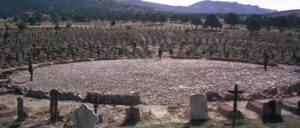
HUGE close-ups

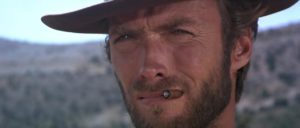

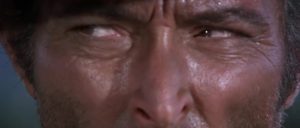
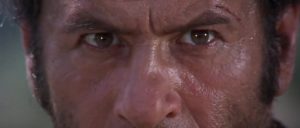

, very little dialogue, long pauses between action scenes, fast, violent shootouts, throwaway lines, etc. Sergio Leone started with one, but its success meant he made two more, and each is better cinematically than the earlier one. (All clickable links in red)
A FISTFUL OF DOLLARS (1964)
Genre: Western
Platform: Amazon Prime
Duration: 1 Hour 35 minutes
Body Count – 60+
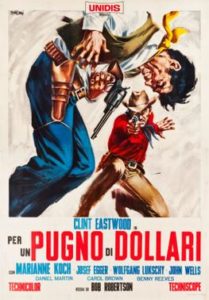 A Fistful of Dollars is a direct remake of the 1961 Akira Kurosawa movie Yojimbo (which was also remade later in Hollywood as Last Man Standing 1996). A man with no name arrives in a town controlled by two families – Baxter and Rojo – violently at loggerheads with each other. He also sees that one of the gangs, the Rojos, is holding a young mother hostage against her will, separated from her husband and son. Soon, he kills four men belonging to the Baxter family. He takes up residence with the Rojos and is soon employed by them. He tricks them into thinking that an attack on the Rojos was actually by the Baxters. The Rojos soon attack the Baxters and kill all of them. “No-name” now turns on the Rojos and cleans up the town.
A Fistful of Dollars is a direct remake of the 1961 Akira Kurosawa movie Yojimbo (which was also remade later in Hollywood as Last Man Standing 1996). A man with no name arrives in a town controlled by two families – Baxter and Rojo – violently at loggerheads with each other. He also sees that one of the gangs, the Rojos, is holding a young mother hostage against her will, separated from her husband and son. Soon, he kills four men belonging to the Baxter family. He takes up residence with the Rojos and is soon employed by them. He tricks them into thinking that an attack on the Rojos was actually by the Baxters. The Rojos soon attack the Baxters and kill all of them. “No-name” now turns on the Rojos and cleans up the town.
The “Sherriff” is owned by the Baxters. There is no law and order. As shown by Ramon Rojo (Gian Maria Volante) happily shooting up a US Army “pay column” and taking its money, money is the only need. It takes an external force to bring order to the feuding town’s terror-stricken citizens.
“No Name” doesn’t speak much. He is quick on the draw and is a mercenary. Yet, he has a sense of “right and wrong” as he frees the woman held hostage, reconciling her with her family, cleans up the town and goes away.
The high body count indicates the overall lawlessness of The West and everyone’s greed. Even the toothless coffin maker is only concerned with how much business he can get daily.
No right. No wrong. Only a sense that things couldn’t get probably worse. Really ? But they do with …..
A FEW DOLLARS MORE (1965)
Genre: Western
Platform: Amazon Prime
Duration: 2 Hours 12 minutes
Body Count – 40+
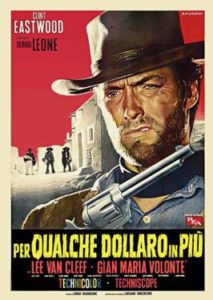 Bounty Hunters “No Name” (Clint Eastwood) sometimes called “Manco” and Colonel Mortimer (Lee van Cleef), are out to get the utterly despicable, sadistic bandit Indio (Gian Maria Volante). Indio has escaped from jail and has regrouped with his gang to commit more robberies. Mortimer and Manco are at loggerheads but decide it’s probably better to be partners than rivals for the same prize. Captured by Indio, they are badly thrashed but escape and soon set about killing Indio’s gang. Mortimer agrees to forego the prize money, and “no Name” learns soon that this is as personal as it is professional.
Bounty Hunters “No Name” (Clint Eastwood) sometimes called “Manco” and Colonel Mortimer (Lee van Cleef), are out to get the utterly despicable, sadistic bandit Indio (Gian Maria Volante). Indio has escaped from jail and has regrouped with his gang to commit more robberies. Mortimer and Manco are at loggerheads but decide it’s probably better to be partners than rivals for the same prize. Captured by Indio, they are badly thrashed but escape and soon set about killing Indio’s gang. Mortimer agrees to forego the prize money, and “no Name” learns soon that this is as personal as it is professional.
Leone has mastered “pacing”. The long pauses are indications of something very violent that will happen soon. (this is in keeping with one classic description by soldiers at war – “long hours of boredom followed by moments of absolute terror). Eastwood had honed his “no expression” face to perfection so much that it was as if it was the only expression through the movie and the series. His “counting error” in the end is a classic in the way he kills the last gang member as if swatting a fly showing both the value of life in the lawless land and the brutality of the greedy bounty hunter. “Munco” even “helps” Mortimer to get his revenge – only for the count.
Trivia: The Hindi film Khotey Sikkey(1974) took the climatic “battle” almost shot by shot except that our hero doesn’t shoot the dacoit in one shot but bashes him up before despatching him to his maker. Oh yes – the theme music of For a few Dollars More also plays in the background. It is also the theme music of Gaddar (1974) which supposedly became Reservoir Dogs, which then became Kaante – a supposed case of Hollywood imitating Bollywood and in turn being imitated! (Perhaps there is a common original but that’s for some other day). This is just to show the popularity of the theme music of For a Few Dollars More.
THE GOOD THE BAD AND THE UGLY (1966)
Genre: Western
Platform: Amazon Prime
Duration: 2 Hours 55 minutes
Body Count – 20+ (excluding the war scenes)
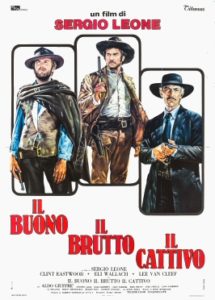 If the previous two “No Name” films showed absolute lawlessness and greed for money, the third film punched the message straight, with no scruples. The “Ugly” Tuco is a lawless, crude, yet cunning bandit on the run who is wanted and has a reward on his head. The “bad” Angel Eyes (Lee van Cleef) is a man seeking information about a stolen consignment of money and ruthlessly killing people who have given him the information to close the trail. The “good” “No Name” (Clint Eastwood) sometimes called “Blondie” by Tuco, is forced to partner with Tuco as they have two halves of the information about the missing money – Tuco knows the gravesite while Blondie/ No Name knows the exact grave number. By mistake, they fall into the hands of Angel Eyes, who is a Sergeant on the “Union” side. While the American Civil War is ongoing, the trio are only concerned with the money and their quest for the loot.
If the previous two “No Name” films showed absolute lawlessness and greed for money, the third film punched the message straight, with no scruples. The “Ugly” Tuco is a lawless, crude, yet cunning bandit on the run who is wanted and has a reward on his head. The “bad” Angel Eyes (Lee van Cleef) is a man seeking information about a stolen consignment of money and ruthlessly killing people who have given him the information to close the trail. The “good” “No Name” (Clint Eastwood) sometimes called “Blondie” by Tuco, is forced to partner with Tuco as they have two halves of the information about the missing money – Tuco knows the gravesite while Blondie/ No Name knows the exact grave number. By mistake, they fall into the hands of Angel Eyes, who is a Sergeant on the “Union” side. While the American Civil War is ongoing, the trio are only concerned with the money and their quest for the loot.
This is simply superb filmmaking, and not a single line or shot is out of scale or place. The “gabby” Tuco gets some of the best lines. The most famous being “If you want to shoot, don’t talk” to a rival who makes a grand statement of finally catching up with him. (The line has been copied at least in two Hindi films that I know of – one each by Ajit and Dharmendra)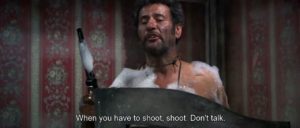
Bigger in scale, including the battle scenes, the film is a sheer delight despite its length of almost 3 hours.
Once again the music is worthy. The final shots show a Tuco running almost crazed in a vast graveyard while the background music complements the flight. So, too, is the final standoff where each is eyeing the other while the music slowly reaches a crescendo in keeping with the character’s mood.
In sum, this is a worthy investment of your time and the trilogy still holds good after all these years. Perhaps it anticipated the “I,Me,Mine” generation sixty years ago 🙂
Script – 5 out of 5
Story – 5 out of 5
Direction – 5 out of 5
Photography – 5 out of 5
Total – 5 out of 5
Rammesh….. What a wonderful review of the old golds, the dollar trilogy. Brought back old memories. Have to watch all the three movies.
I watched it 10 years ago. I watched it about a month ago and it still stands the test of time.